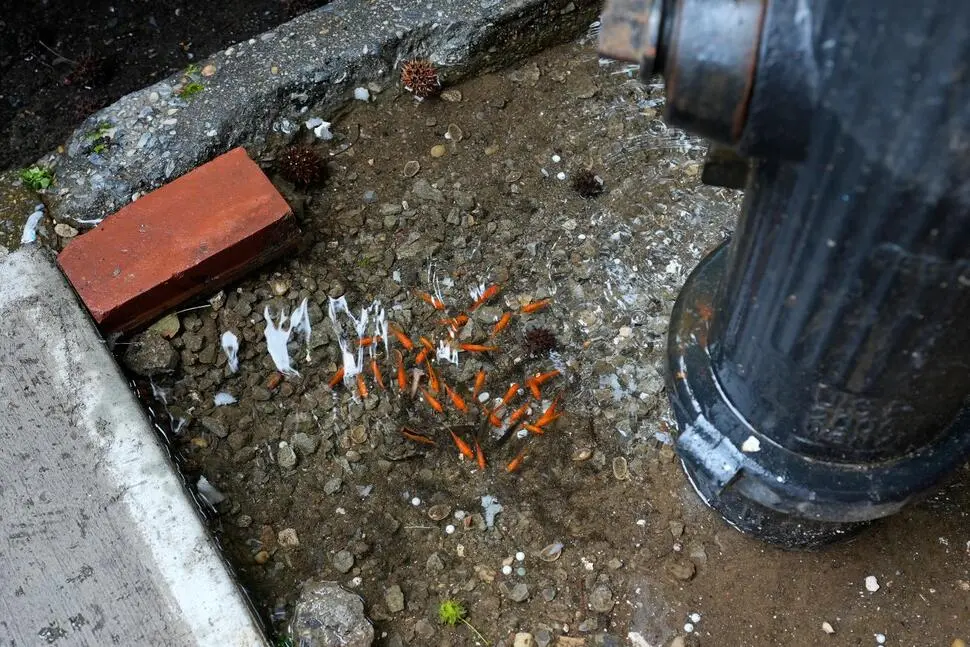NEW YORK (AP) — Last week, a couple of long-time Brooklyn residents, lounging in the summer heat, looked at a sidewalk tree pit frequently flooded by a leaky fire hydrant and conceived a unique idea: a makeshift aquarium.
“We joked about adding fish,” recalled Hajj-Malik Lovick, 47, a Bedford-Stuyvesant native. “Since the water is always there in the puddle, why not turn it into something more interesting?”
After reinforcing the edges of the tree bed with rocks and bricks, they bought 100 goldfish from a pet store for $16 and introduced them to their new home. The sight of tiny fish swimming in the shallow basin quickly captured the neighborhood’s imagination, earning it the nickname “the Hancock Street Bed-Stuy Aquarium.”
However, as videos and news reports about the fish pit spread online, concerns arose from city officials and animal rights advocates. In the early hours of Wednesday, local residents Emily Campbell and Max David conducted a rescue mission. They used nets and plastic bags to remove about 30 fish from the shallow water, citing inhumane conditions.
This intervention sparked a heated debate about gentrification in the historically Black neighborhood, which has seen an influx of younger, predominantly white residents in recent years.
“I understand the sensitivity of a white person coming into a long-established Black neighborhood and telling someone who’s been here their whole life what to do,” Campbell, a fish enthusiast with a background in aquaponics, said. “I sympathize with that, but I couldn’t stand to see the fish suffocating in their own waste.”
Campbell, 29, said she was working to rehome the rescued fish, some of which were being kept in her apartment. While she remains concerned for the remaining fish, she is also worried about the community’s division.
Proponents of the sidewalk aquarium argue that it has brought enrichment to the neighborhood and improved the lives of the goldfish, which are usually sold as food for larger marine species. The fish are fed three times a day, and their caretakers ensure the fire hydrant maintains a slow trickle.
“I feel like we’re helping the goldfish,” Lovick said. “People are coming in and trying to change things.”
In recent days, supporters have donated decorations like pearls and seashells, as well as food. Floyd Washington, one of the pond’s monitors, noted that the aquarium has fostered community interactions. “People stop on their way to work, see something serene, and meet their neighbors. Now, we share the fish as a common interest.”
The group plans to keep the fish in the pit for about two more weeks before donating them to local children. On Friday, the visitors included grocery workers, an actor, and a wide-eyed toddler whose nanny had learned about the aquarium on the news.
“It’s a beautiful guerilla intervention,” said Josh Draper, an architect and goldfish keeper from Bed-Stuy. “It’s making the city feel alive.”
A passerby suggested the fish might soon become “rat food.” “Nah,” Washington responded, pointing to a black fish named after the city’s mayor, Eric Adams. “No one messes with him.”
Adams did not respond to a request for comment. However, Beth DeFalco, a spokesperson for the city’s Department of Environmental Protection, expressed concerns about the safety of leaking hydrants. Despite multiple repair attempts, residents had repeatedly turned the hydrant back on.
“We love goldfish too, but they deserve a better home than a sidewalk,” DeFalco said.
As of Friday afternoon, many fish were still swimming in the pit.
